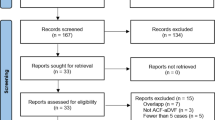Abstract
Introduction
From January 1998 to December 2002, endovascular treatment (EVT) was used as first intention in all patients with ruptured aneurysms. The objective of this study was to analyze the results of this therapeutic strategy.
Methods
Among 401 patients admitted with a subarachnoid hemorrhage (SAH), 73 (18%) had a nonaneurysmal perimesencephalic SAH, 28 were not explored by angiography due to very poor clinical status, and 28 with aneurysmal SAH were not treated due to poor clinical status. Thus, of the 300 patients with a proven aneurysmal SAH, 272 (83%) were treated. EVT was attempted in 230 patients and was successful in 222 (82%), and clipping was performed in 50 (18%).
Results
Finally, EVT was successful in 234 aneurysms (96.7%) in 222 patients out of 242 aneurysms in 230 patients (some of the patients were treated for more than one aneurysm in the same procedure). EVT-related morbidity occurred in ten patients (4.5%) and mortality in eight (3.6%). Rate of dependency or death (modified Rankin scale 3–5) was 24.5% at 26 months. Initially, complete aneurysm occlusion was obtained in 81%, a dog ear in 3.4%, a neck remnant in 8% and incomplete occlusion in 8.1% of the patients. At follow-up (mean 26 months), the occlusion rate remained stable at 75%.
Conclusion
This consecutive prospective series shows that EVT can be performed routinely as first-intention treatment in most aneurysmal SAH. Using this therapeutic strategy, EVT was performed in 82% of patients with long-term clinical results similar to those of the ISAT study.
Similar content being viewed by others
References
Baltsavias GS, Byrne JV, Halsey J, Coley SC, Sohn MJ, Molyneux AJ (2000) Effects of timing of coil embolization after aneurysmal subarachnoid hemorrhage on procedural morbidity and outcomes. Neurosurgery 47:1320–1329; discussion 1329–1331
Byrne JV, Sohn MJ, Molyneux AJ, Chir B (1999) Five-year experience in using coil embolization for ruptured intracranial aneurysms: outcomes and incidence of late rebleeding. J Neurosurg 90:656–663
Cognard C, Weill A, Castaings L, Rey A, Moret J (1998) Intracranial berry aneurysms: angiographic and clinical results after endovascular treatment. Radiology 206:499–510
Cognard C, Weill A, Spelle L, Piotin M, Castaings L, Rey A, Moret J (1999) Long-term angiographic follow-up of 169 intracranial berry aneurysms occluded with detachable coils. Radiology 212:348–356
Fisher CM, Kistler JP, Davis JM (1980) Relation of cerebral vasospasm to subarachnoid hemorrhage visualized by computerized tomographic scanning. Neurosurgery 6:1–9
Fridriksson S, Saveland H, Jakobsson KE, Edner G, Zygmunt S, Brandt L, Hillman J (2002) Intraoperative complications in aneurysm surgery: a prospective national study. J Neurosurg 96:515–522
Molyneux A, Kerr R, Stratton I, Sandercock P, Clarke M, Shrimpton J, Holman R; International Subarachnoid Aneurysm Trial (ISAT) Collaborative Group (2002) International Subarachnoid Aneurysm Trial (ISAT) of neurosurgical clipping versus endovascular coiling in 2143 patients with ruptured intracranial aneurysms: a randomised trial. Lancet 360:1267–1274
Henkes H, Fischer S, Weber W, Miloslavski E, Felber S, Brew S, Kuehne D (2004) Endovascular coil occlusion of 1811 intracranial aneurysms: early angiographic and clinical results. Neurosurgery 54:268–280; discussion 280–285
Kassell NF, Torner JC, Haley EC Jr, Jane JA, Adams HP, Kongable GL (1990) The International Cooperative Study on the Timing of Aneurysm Surgery. Part 1: Overall management results. J Neurosurg 73:18–36
Kassell NF, Torner JC, Jane JA, Haley EC Jr, Adams HP (1990) The International Cooperative Study on the Timing of Aneurysm Surgery. Part 2: Surgical results. J Neurosurg 73:37–47
Kuether TA, Nesbit GM, Barnwell SL (1998) Clinical and angiographic outcomes, with treatment data, for patients with cerebral aneurysms treated with Guglielmi detachable coils: a single-center experience. Neurosurgery 43:1016–1015
Malisch TW, Guglielmi G, Vinuela F, Duckwiler G, Gobin YP, Martin NA, Frazee JG (1997) Intracranial aneurysms treated with the Guglielmi detachable coil: midterm clinical results in a consecutive series of 100 patients. J Neurosurg 87:176–183
Moret J, Cognard C, Weill A, Castaings L, Rey A (1997) Reconstruction technique in the treatment of wide-neck intracranial aneurysms. Long-term angiographic and clinical results. Apropos of 56 cases (in French). J Neuroradiol 24:30–44
Murayama Y, Nien YL, Duckwiler G, Gobin YP, Jahan R, Frazee J, Martin N, Vinuela F (2003) Guglielmi detachable coil embolization of cerebral aneurysms: 11 years’ experience. J Neurosurg 98:959–966
Ng P, Khangure MS, Phatouros CC, Bynevelt M, ApSimon H, McAuliffe W (2002) Endovascular treatment of intracranial aneurysms with Guglielmi detachable coils: analysis of midterm angiographic and clinical outcomes. Stroke 33:210–217
Niemann DB, Wills AD, Maartens NF, Kerr RS, Byrne JV, Molyneux AJ (2003) Treatment of intracerebral hematomas caused by aneurysm rupture: coil placement followed by clot evacuation. J Neurosurg 99:843–847
Rankin J (1957) Cerebral vascular accidents in patients over the age of 60. II. Prognosis. Scott Med J 2:200–215
Raymond J, Roy D (1997) Safety and efficacy of endovascular treatment of acutely ruptured aneurysms. Neurosurgery 41:1235–1245; discussion 1245–1246
Sluzewski M, van Rooij WJ, Rinkel GJ, Wijnalda D (2003) Endovascular treatment of ruptured intracranial aneurysms with detachable coils: long-term clinical and serial angiographic results. Radiology 227:720–724
Teasdale GM, Drake CG, Hunt W, Kassell N, Sano K, Pertuiset B, De Villiers JC (1988) A universal subarachnoid hemorrhage scale: report of a committee of the World Federation of Neurosurgical Societies. J Neurol Neurosurg Psychiatry 51:1457
Thornton J, Debrun GM, Aletich VA, Bashir Q, Charbel FT, Ausman J (2002) Follow-up angiography of intracranial aneurysms treated with endovascular placement of Guglielmi detachable coils. Neurosurgery 50:239–249; discussion 249–250
Tummala RP, Chu RM, Madison MT, Myers M, Tubman D, Nussbaum ES (2001) Outcomes after aneurysm rupture during endovascular coil embolization. Neurosurgery 49:1059–1066; discussion 1066–1067
Vinuela F, Duckwiler G, Mawad M (1997) Guglielmi detachable coil embolization of acute intracranial aneurysm: perioperative anatomical and clinical outcome in 403 patients. J Neurosurg 86:475–482
Conflict of interest statement
We declare that we have no conflict of interest.
Author information
Authors and Affiliations
Corresponding author
Rights and permissions
About this article
Cite this article
Mejdoubi, M., Gigaud, M., Trémoulet, M. et al. Initial primary endovascular treatment in the management of ruptured intracranial aneurysms: a prospective consecutive series. Neuroradiology 48, 899–905 (2006). https://doi.org/10.1007/s00234-006-0144-6
Received:
Accepted:
Published:
Issue Date:
DOI: https://doi.org/10.1007/s00234-006-0144-6




